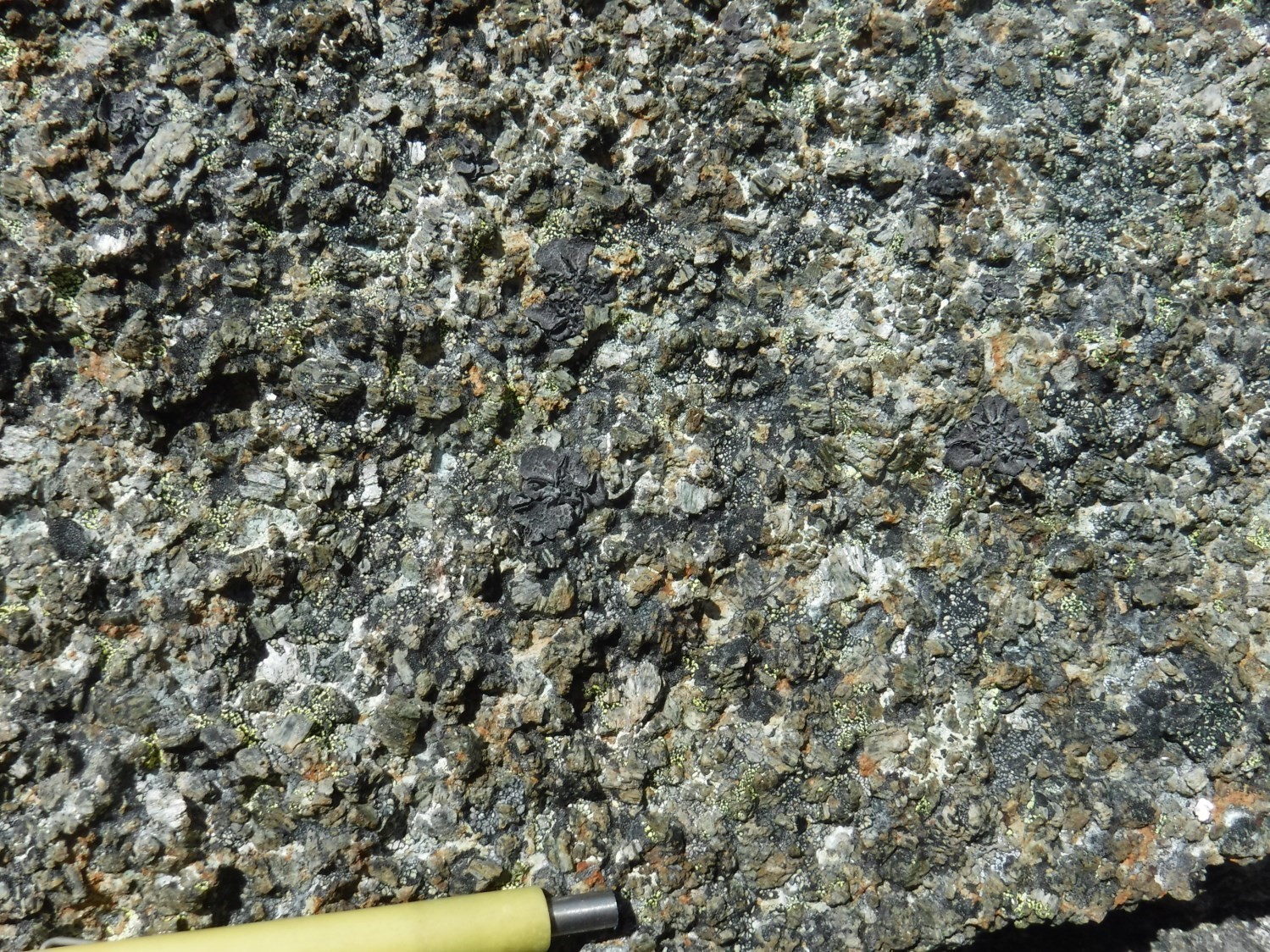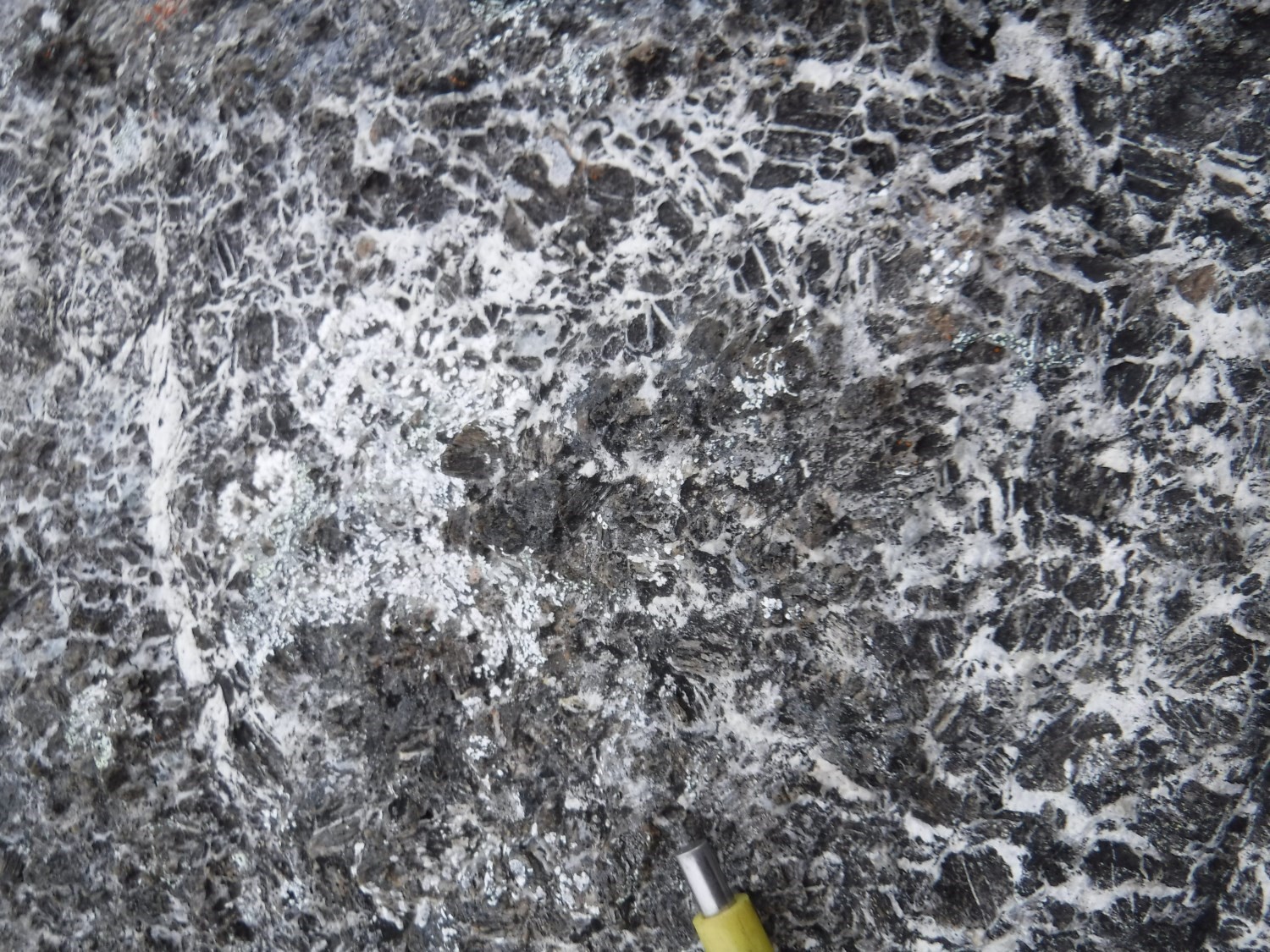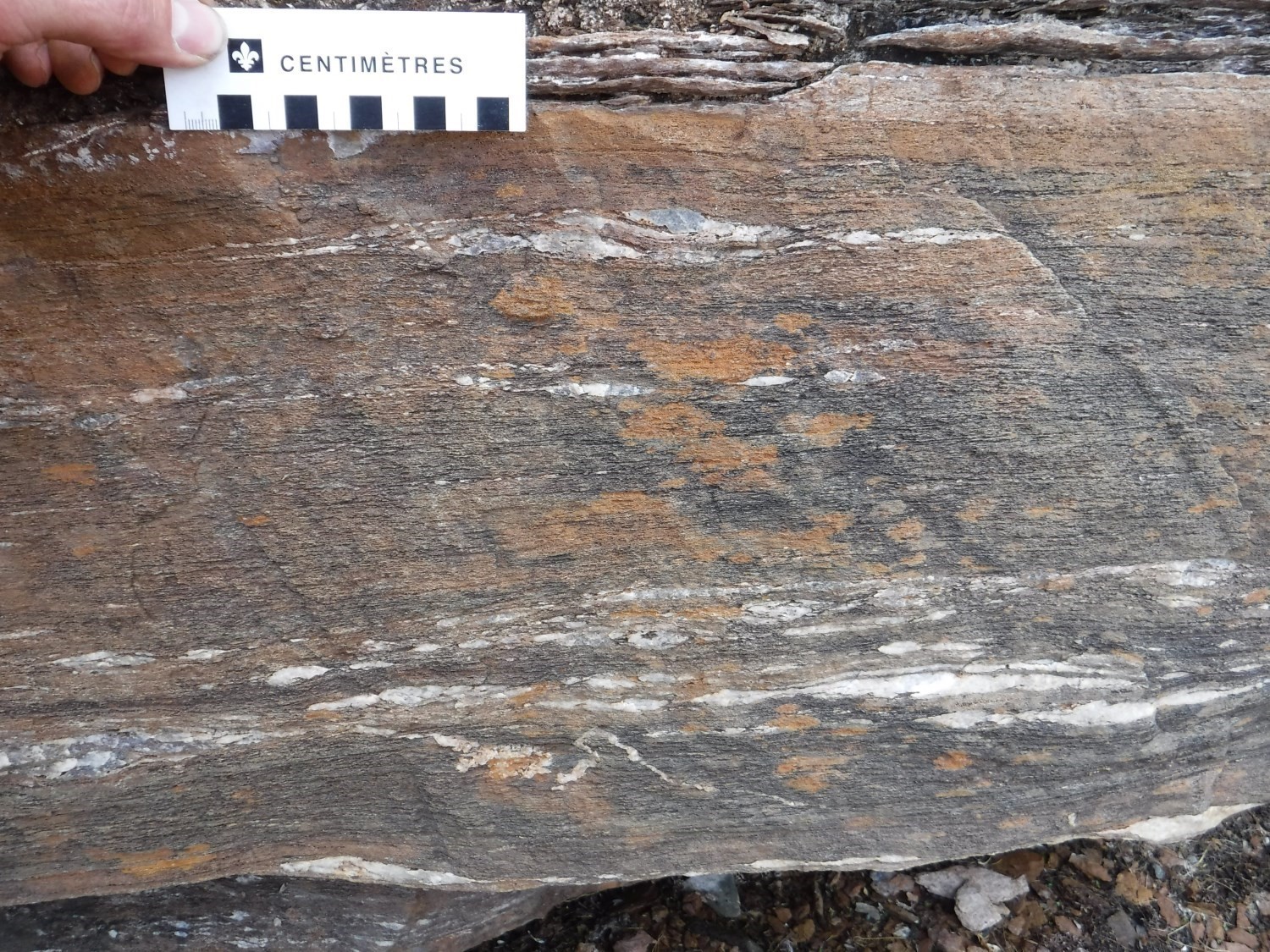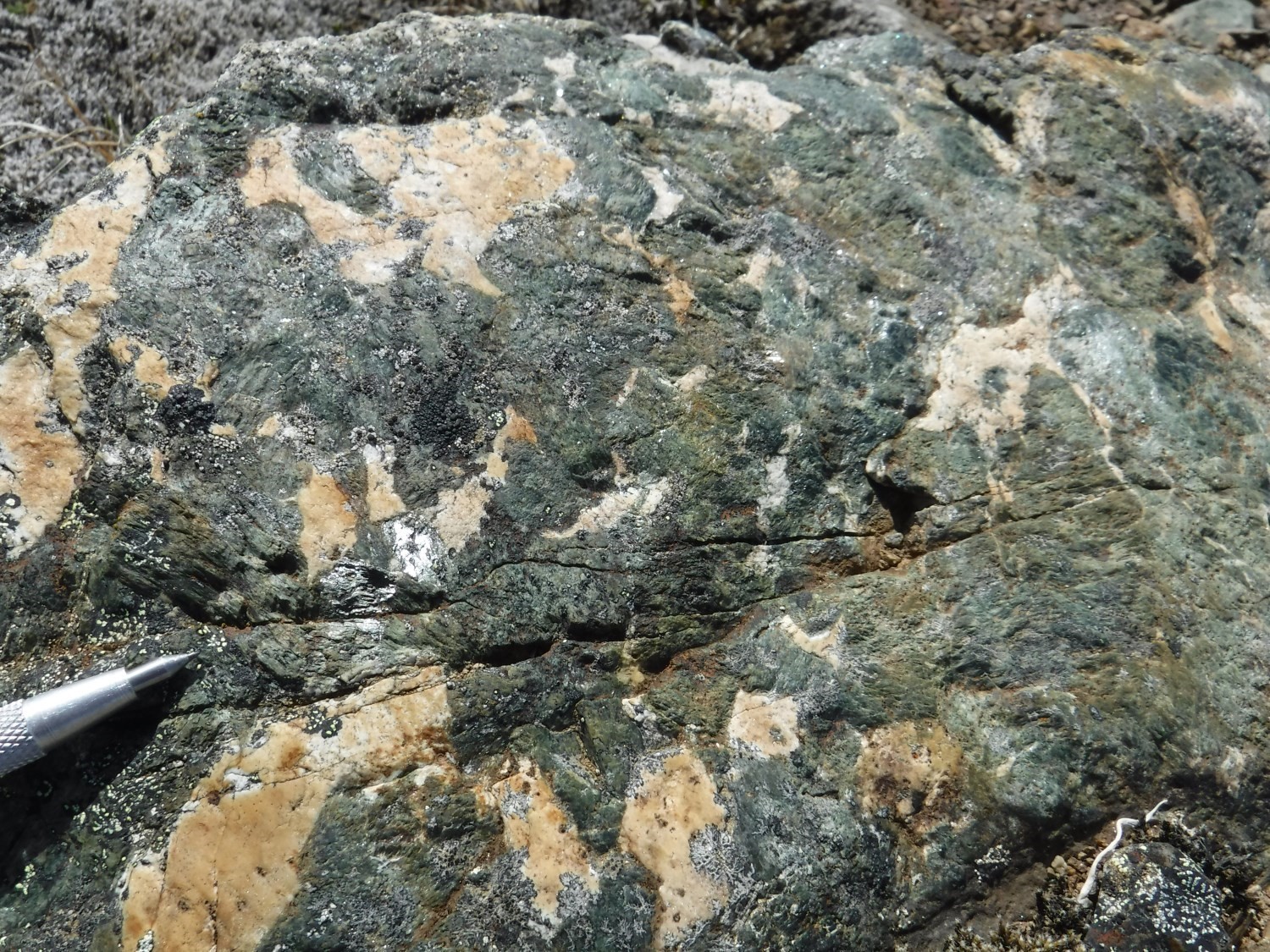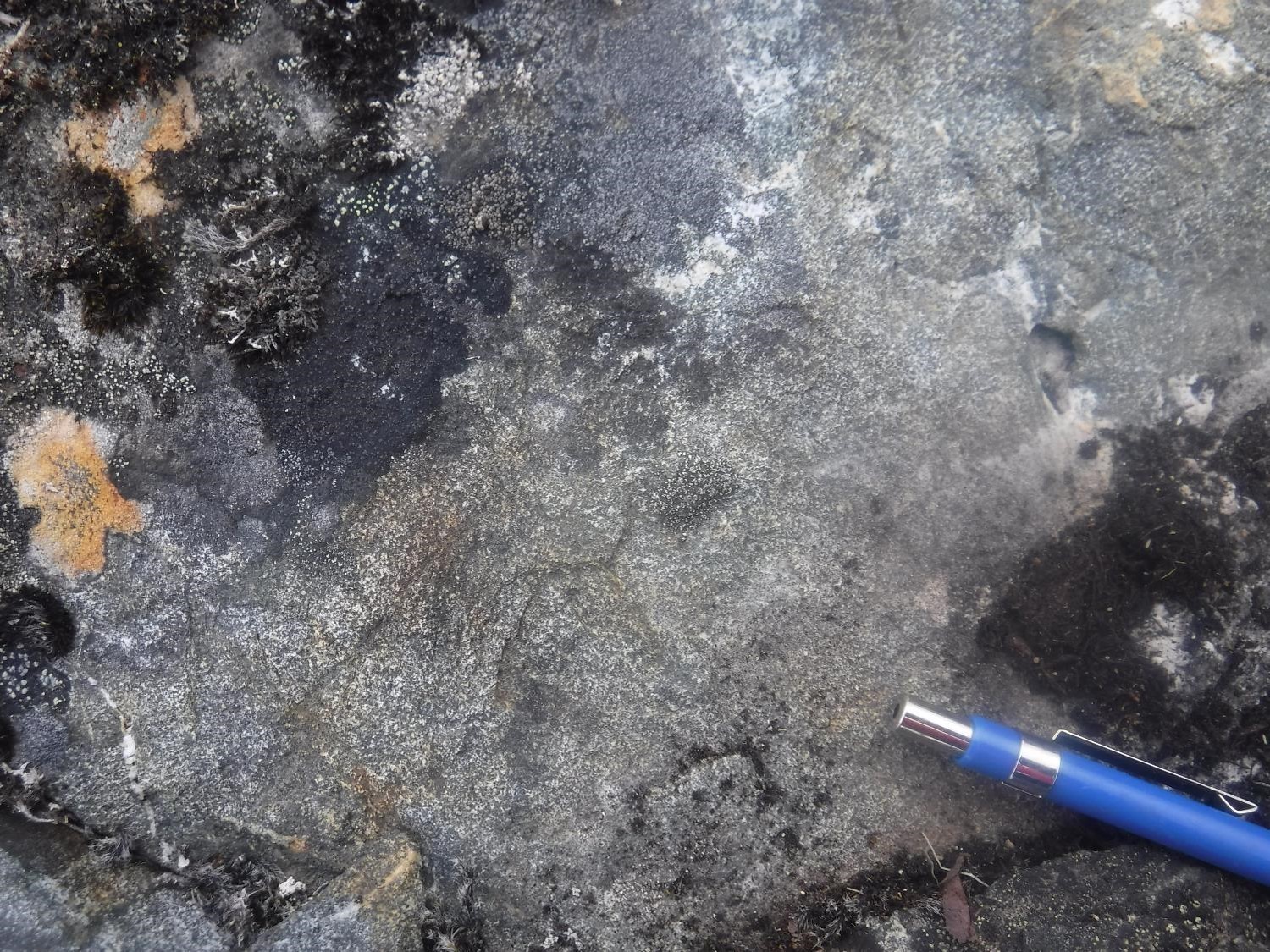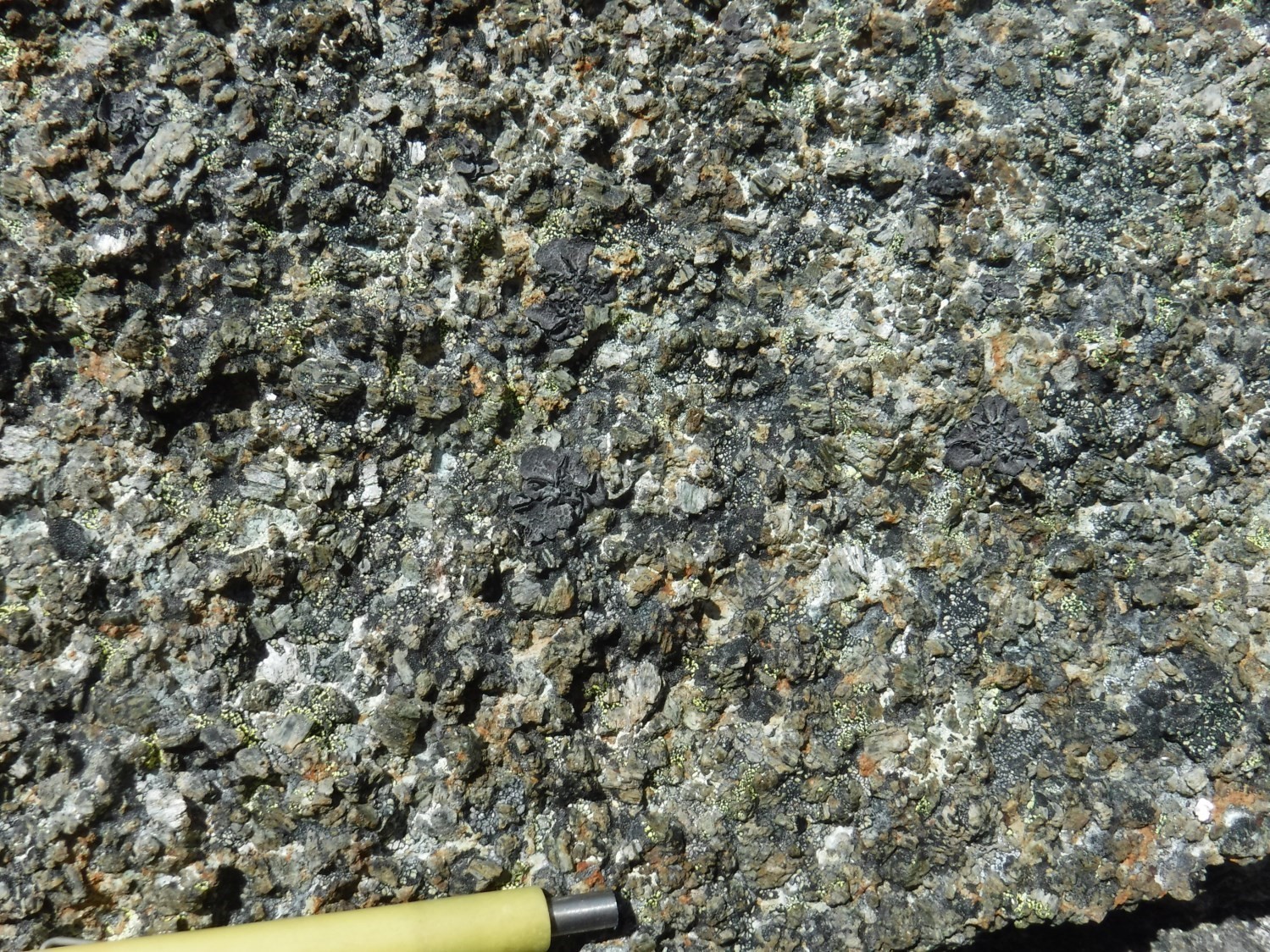
| Author: | Mathieu and Beaudette, 2019 |
| Age: | Paleoproterozoic |
| Reference section: | None |
| Type area: | West of Watts Lake (NTS sheet 35G16) |
| Geological province: | Churchill Province |
| Geological subdivision: | Ungava Orogen /Northern Domain |
| Lithology: | Ultramafic intrusion |
| Type: | Lithodemic |
| Rank: | Lithodeme |
| Status: | Formal |
| Use: | Active |
None
Background
The Illuinaqtuut Suite was introduced by Mathieu and Beaudette (2019) to name an ultramafic intrusion dominated by a kilometre-sized homogeneous grey pyroxenite, previously assigned to the Watts Group by St-Onge and Lucas (1989). The post-cinematic character of the pluton was considered by Mathieu and Beaudette (2019) to remove the unit from the Watts Group. Following mapping in the summer of 2021, this pluton was upgraded to suite status to comply with the North American Stratigraphic Code (Mathieu et al., 2022).
Description
The Illuinaqtuut Suite is a polyphase, bedded magnesian laccolite (Mathieu et al., 2023). Most of the unit is ultramafic with a massive, homogeneous, grey pyroxenite main phase (pPiqt1b). It also includes peridotite (pPiqt1a) and dunite (pPiqt1c). All three phases outcrop in places on the same outcrop. They display the classic cogenetic relationships of bedded ultramafic intrusions (very sharp contacts, disorganized primary bedding, simultaneous cross-cutting) characteristic of a partially preserved magma chamber arrangement.
A particular phase (pPiqt2) composed of very coarse gabbro and hornblendite forms a border around the main intrusions. It is interpreted as an edge or early phase.
Another secondary phase (pPiqt3) is composed of norite with olivine cumulates. Its REE and multi-element geochemical signature is similar to that of the pPiqt2 unit.
Illuinaqtuut Pluton 1 (pPiqt1): Coarse-Grained Pyroxenite
This unit is defined by four subunits: pPiqt1a to pPiqt1d.
Illuinaqtuut Pluton 1a (pPiqt1a): Coarse-Grained Peridotite
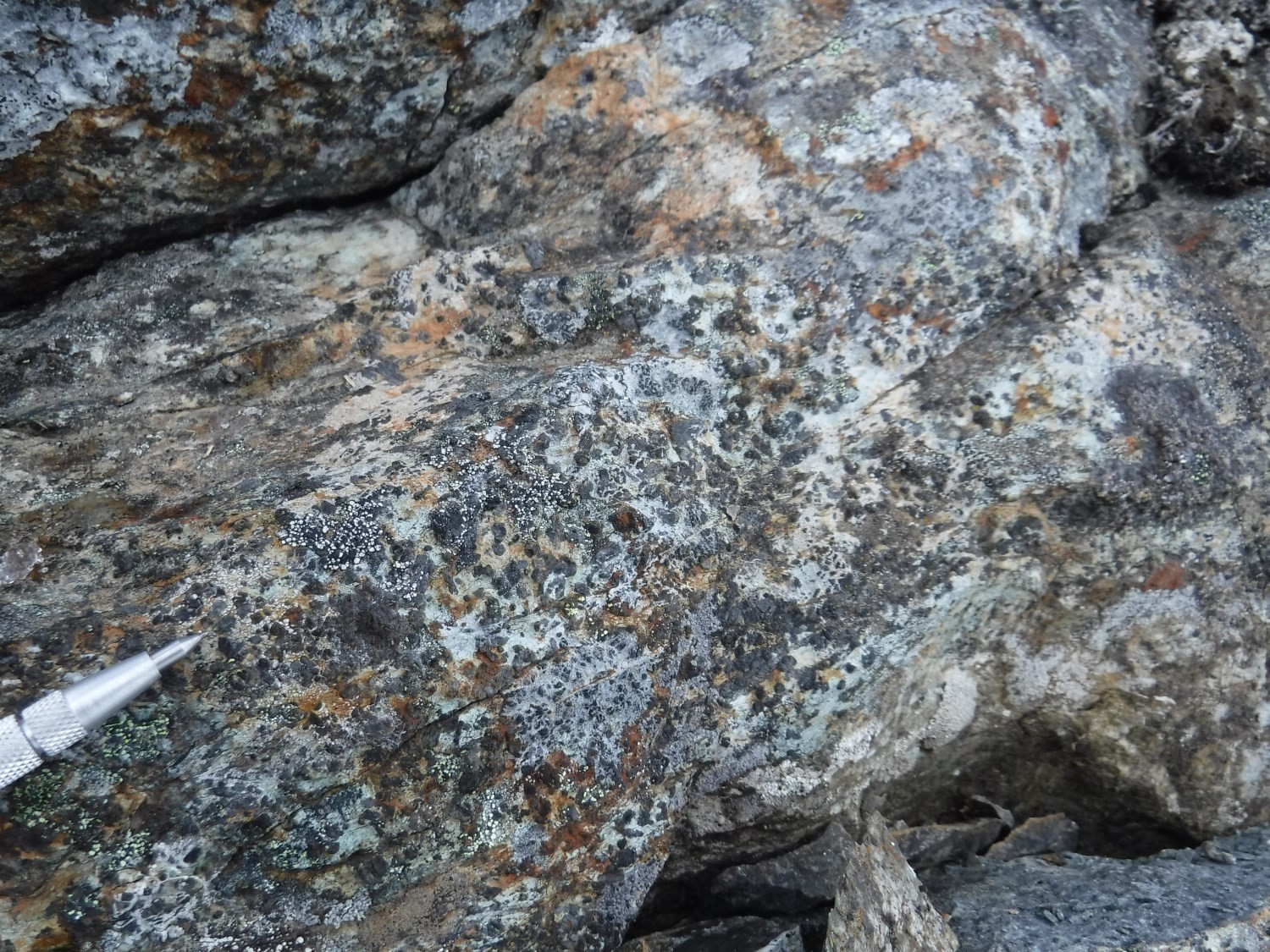 Peridotite is lherzolite. It has a grey to brownish-red patina and a very dark grey fresh surface. It is characterized by high magnetic susceptibility. The magmatic bedding is defined by alternating cumulative centimetric bands with a grey patina composed of pyroxene crystals in an olivine matrix, and reddish olivine bands containing a lesser proportion of pyroxene. This subunit also outcrops as a homogeneous lherzolite in which centimetric crystals of isolated orthopyroxene and clinopyroxene (20-40%) are set in an olivine matrix. Olivine accounts for 40-85% of the mode. Orthopyroxene makes up 20-40% of pyroxenes, and is therefore in the minority compared with clinopyroxene. Magnesian phases are altered to serpentine and talc in variable proportions. Clinopyroxene is uralitized to tremolite.
Peridotite is lherzolite. It has a grey to brownish-red patina and a very dark grey fresh surface. It is characterized by high magnetic susceptibility. The magmatic bedding is defined by alternating cumulative centimetric bands with a grey patina composed of pyroxene crystals in an olivine matrix, and reddish olivine bands containing a lesser proportion of pyroxene. This subunit also outcrops as a homogeneous lherzolite in which centimetric crystals of isolated orthopyroxene and clinopyroxene (20-40%) are set in an olivine matrix. Olivine accounts for 40-85% of the mode. Orthopyroxene makes up 20-40% of pyroxenes, and is therefore in the minority compared with clinopyroxene. Magnesian phases are altered to serpentine and talc in variable proportions. Clinopyroxene is uralitized to tremolite.
Illuinaqtuut Pluton 1b (pPiqt1b): Coarse-Grained Pyroxenite
Coarse-grained pyroxenite is the main facies of the intrusion. It consists of a very homogeneous and massive pyroxenite, displaying medium to coarse pyroxene joint crystals. The alteration patina is dark grey and the fresh surface is medium to dark grey. Very locally, pyroxenes are no longer joint. This unit is characterized by high magnetic susceptibility. St-Onge and Lucas (1992) described this unit as follows: “Pyroxenites are massive and composed chiefly of primary and coarse pyroxenes. Hornblende is observed in smaller lithological bodies. Based on crosscutting relationships, it appears that pyroxenites are intrusive within layered gabbro units located on the edges.”
Under the microscope, pyroxenite is composed of coarse clinopyroxene (60-70%), coarse orthopyroxene (10-30%), up to 15% serpentine-carbonate-magnetite-crowned olivine relics and up to 5% euhedral magnetite. Uralitization is commonly observed, with thin rods of tremolite (to the south) or hornblende (to the north) developing at the edge of clinopyroxene crystals and to the detriment of the latter. Opaque mineral lamellae grow in the cleavage of pyroxenes.
Illuinaqtuut Pluton 1c (pPiqt1c): Dunite
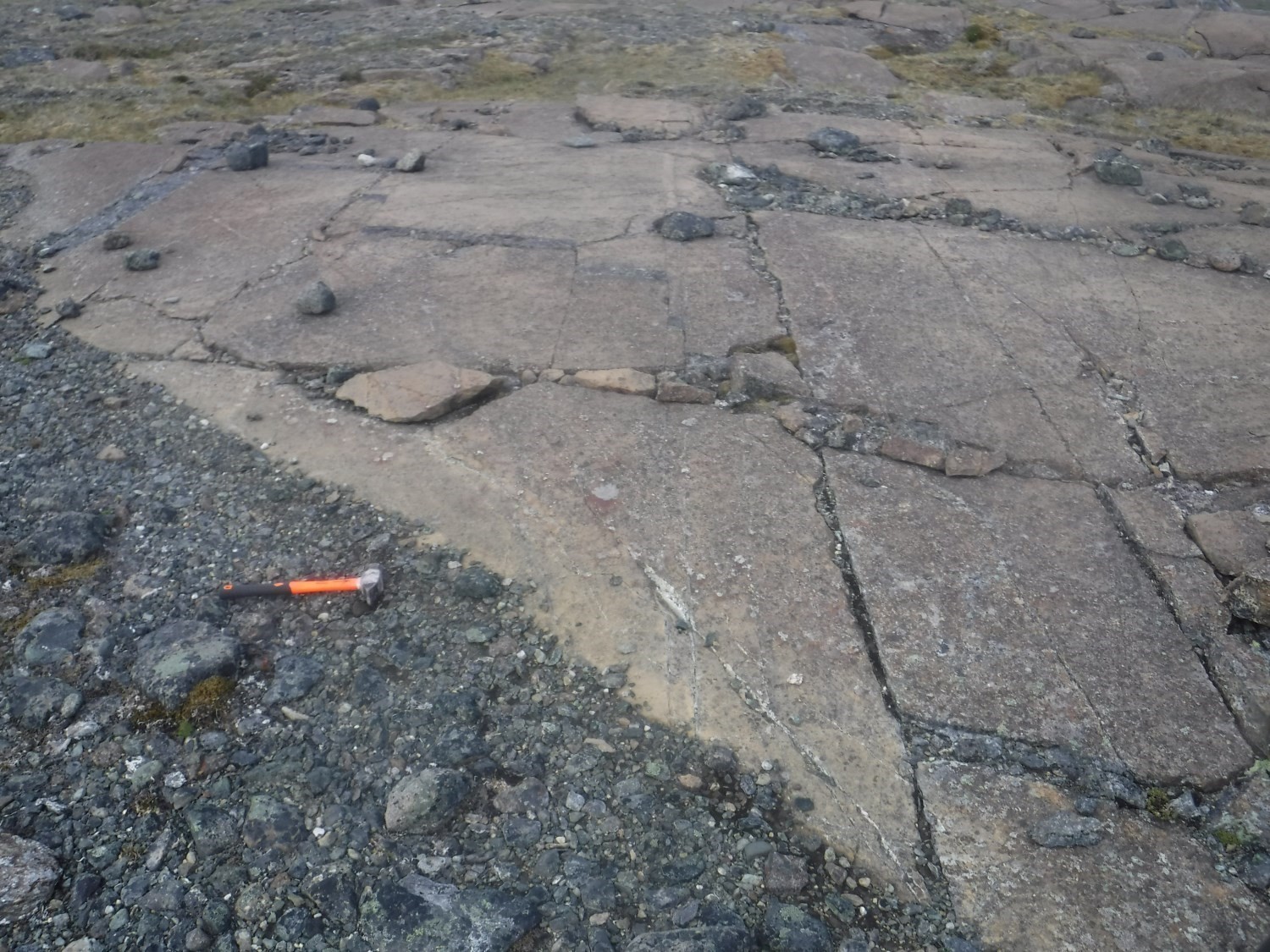 Dunite has a characteristic buff colour and a very dark gray fresh surface with a green shine. Primary bedding is defined by thin, discontinuous beds of euhedral chromite. Locally, podiform chromite mineralization is observed.
Dunite has a characteristic buff colour and a very dark gray fresh surface with a green shine. Primary bedding is defined by thin, discontinuous beds of euhedral chromite. Locally, podiform chromite mineralization is observed.
Under the microscope, olivine is replaced to varying degrees by serpentine meshwork and, to a lesser extent, talc rosettes. Chromite is surrounded by a crown of magnetite, the whole respecting an euhedral spinel habitus. Sulfides are commonly observed in trace amounts and consist of euhedral pyrrhotite and chalcopyrite.
Illuinaqtuut Pluton 1d (pPiqt1d): Altered Ultrmafic Rock
This subdivision groups several distinct alteration facies. The first involves intense serpentinization of ultramafic rocks. Relics of olivine crystals are surrounded by a crown of magnetite. The samples are composed, in order of importance, of serpentine (75-95%), talc, brown carbonate and an unidentified brown oxide. Two generations of serpentine are observed. The first is composed of antigorite fibers defininf the fliation, the second of unoriented chrysotile fibers. The existence of the deformed generation is compatible with ante-kinetic hydrothermal alteration, which may have occurred as early as the emplacement of ultramafic rocks.
The second facies corresponds to carbonatation and silicification that seems to post-date emplacement. This type of alteration is confined to the edge of the Illuinaqtuut Suite intrusions and to deformation zones. Secondary mineral phases include brown carbonate (5-80%) with iron and magnesium oxide inclusion and rim, granoblastic quartz in lenses and clusters (trace to 25%), acicular talc clusters (5-35%), fuchsite sheets (trace to 3%), dark sheets of chlorite, chromite and trace euhedral sulfides. Quartz veins and veinlets are commonly observed in such outcrops.
Chrysotile veins and veinlets in radial lamellae striate most of the outcrops in the Illuinaqtuut Suite.
Illuinaqtuut Pluton 2 (pPiqt2): Coarse-Grained Hornblendite, Very Coarse-Grained Gabbro
This unit outcrops on the southern and northeastern edges of the pluton. It consists of heterogranular (coarse-grained to pegmatitic) and massive mesogabbro. The alteration patina is white and green. Clinopyroxenes are poikilitic and include quartz and magnetite grains.
Illuinaqtuut Pluton 3 (pPiqt3): Massive Medium-Grained Clinopyroxene Norite Containing Olivine Cumulate
The unit consists of highly to moderately magnetic ophitic to subophitic norite. In outcrop, the unit is described as massive and mesocratic to melanocratic. Its patina is a mosaic of dark grey and light beige. Its fresh surface is black. Locally, its composition evolves towards gabbronorite. A brownish layer of olivine cumulates with a pyroxene matrix has been observed. These compositional variations are evidence of magmatic bedding of decametric amplitude.
Norite is composed of 70-80% pyroxene, almost exclusively orthopyroxene, and 20-30% plagioclase. Under the microscope, orthopyroxene intergrows with orthoamphibole. Traces of primary hornblende and apatite are observed. Actinote develops at the expense of ferromagnesian phases. Plagioclase is partially replaced by an assemblage of zoïsite and pistachite. Magnetite, and to a lesser extent pyrrhotite, constitute the opaque phases. Pyroxene, replaced by amphibole, exhibits an oxide exsolved in the cleavage.
The cumulate layer is composed of 60% subhedralc to euhedral crystals of totally serpentinized olivine in large crystals of pœcilitic orthopyroxene replaced by amphibole. Clinopyroxene (5%) is also observed. Secondary actinote-tremolite is reported. The weak deformation is underlined by the very slight rotation of the latter mineral phase, implying late-kinematic emplacement and metamorphism.
Thickness and Distribution
The Illuinaqtuut Suite outcrops west of Watts Lake and around Serpentine Lake. Its main body, in sheet 36G16, forms a large hook-shaped mass that extends over 15 km long and 600 m to 5 km wide. Further west (sheet 35G15), the Illuinaqtuut Suite forms small topographic highs. The suite is easily recognized on aeromagnetic maps (Intissar et al., 2014) by its very high magnetic susceptibility, compared to gabbro and basalt of the host Watts Group (interactive map). More specifically, the pluton has high susceptibility ridges, irregular and elongated in shape, usually subparallel to contact with surrounding units. It is also roughly defined by an area of low thorium and potassium contents on radiometric surveys (interactive map). The pPiqt3 unit outcrops west of Spartan Lake and covers an area of ~1.75 km2.
Dating
None.
Stratigraphic Relationship(s)
The Illuinaqtuut Pluton is intrusive into Watts Group gabbro. On outcrop 18-GM-5048, the pluton indeed cuts highly deformed anorthosite of subunit pPwa3i, which is also found as deformed angular enclaves on the same outcrop. It cuts volcanic rocks of the Watts Group and intrusive rocks of the Vanasse Suite (Mathieu et al., 2023). The Illuinaqtuut Suite also punches through the Ombillic Fault, which marks the overthrusting of volcanic rocks of the Parent Group onto sedimentary rocks of the Spartan Group (Mathieu et al., 2023). The Illuinaqtuut Suite also cuts the Vanasse Suite.
The Niqituraaqiaruk Suite intersects ultramafic rocks of the Illuinaqtuut Suite. This observation was made west of Serpentine Lake (Mathieu et al., 2023).
Paleontology
Does not apply.
References
Publications available through Sigéom Examine
INTISSAR, R., BENAHMED, S., D’AMOURS, I., 2014. LEVE MAGNETIQUE ET SPECTROMETRIQUE AEROPORTE DE LA PARTIE NORD DE L’OROGENE DE L’UNGAVA, PROVINCE DE CHURCHILL. MRN; DP 2014-03, 10 pages, 410 plans.
LAMOTHE, D. 2007. Lexique stratigraphique de l’Orogène de l’Ungava. Ministère des Ressources naturelles et de la Faune, Québec; DV 2007-03, 66 pages and 1 plan.
MATHIEU, G., BEAUDETTE, M. 2019. Géologie de la région du lac Watts, Domaine Nord, Fosse de l’Ungava, Nunavik, Québec, Canada. MERN. BG 2019-04.
MATHIEU, G., VANIER, M.-A., DEBRUYNE, T., 2022. Géologie de la région du lac Spartan, Orogène de l’Ungava, Nunavik, Québec, Canada. MERN; BG 2022-06, 1 plan.
MATHIEU, G., VANIER, M.-A., DEBRUYNE, T., 2023. Géologie de la région du lac Serpentine, Domaine Nord, Orogène de l’Ungava, Nunavik, Québec, Canada; MRNF; BG 2023-04, 1 plan.
Other publications
St-Onge, M.R., Lucas, S.B. 1989a. Géologie, Lac Watts, Québec. Geological Survey of Canada, « A » Series Map 1721A, 1 sheet. doi.org/10.4095/127673.
St-Onge, M.R., Lucas, S.B. 1992. New insight on the crustal structure and tectonic history of the Ungava Orogen, Kovik Bay and Cap Wolstenholme, Quebec. Geological Survey of Canada; Paper 92-1C, pages 31–41. doi.org/10.1139/e92-064.
Taylor, F.C. 1982. Reconnaissance geology of a part of the Canadian Shield, northern Quebec and Northwest Territories. Geological Survey of Canada, Memoir 399, 32 pages (7 sheets). doi.org/10.4095/109241.
Suggested Citation
Ministère des Ressources naturelles et des Forêts (MRNF). Illuinaqtuut Suite. Quebec Stratigraphic Lexicon. https://gq.mines.gouv.qc.ca/lexique-stratigraphique/province-de-churchill/pluton-illuinaqtuut_en [accessed on Day Month Year].
Contributors
|
First publication |
Guillaume Mathieu, Eng., M.Sc. guillaume.mathieu@mrnf.gouv.qc.ca; Mélanie Beaudette, P.Geo., B.Sc. (redaction) Mehdi A. Guemache, P.Geo., Ph.D. (coordination); James Moorhead, P.Geo., M.Sc. (critical review); Simon Auclair, P.Geo., M.Sc. (editing); Céline Dupuis, P.Geo., Ph. D. (English version); Ricardo Escobar Moran (HTML editing). |
|
Revision(s) |
Guillaume Mathieu, Eng., M.Sc.; Thomas Debruyne, GIT, B.Sc. (redaction) Céline Dupuis, P.Geo., Ph. D. (coordination); Yannick Daoudene, P.Geo., Ph.D. (critical review); Simon Auclair, P.Geo., M. Sc. (editing); Céline Dupuis, P.Geo., Ph. D. (English version). |



